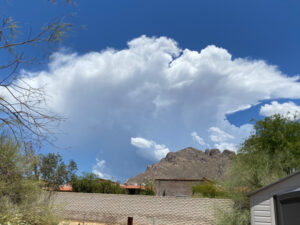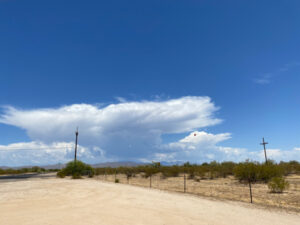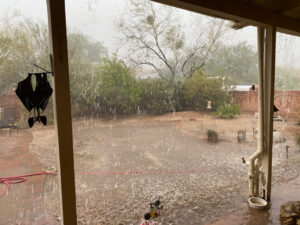Here in the Sonoran Desert, changes in the weather occur before the monsoons arrive. Humidity and dew points increase. Replacing our comfortable dry heat – when sweat evaporates immediately. After all, in 100+ degree weather, the body needs to sweat. But sweat remained on my skin when I lived in the South, beading up and forming rivers flowing all over my body. We would say we were “glowing.” During this pre-monsoon period in the desert, I glow rivers. This misery is worth it if it causes the monsoon clouds to build.
How to Make a Monsoon
I search Pusch Ridge of the Santa Catalina Mountains daily, hoping to see clouds forming. Not the thin, wispy clouds, but mighty, towering clouds! Once clouds are spotted, I start communicating with these masses of water vapor.

With the first sign of the clouds behind Pusch Ridge, I start the conversation. I speak words of encouragement, cheering on the gathering. However, hours creep by, and the clouds build too slowly. The stimulating heat is lost if the rain doesn’t come before sunset, and the clouds must start again. Encouragement turns to complaints. Why aren’t you building faster? If you don’t develop more quickly, you won’t have enough energy to rain!
Early in the season, we have the danger of virga, when rain falls from the clouds but evaporates before it reaches the ground. No nonsense like that will be tolerated.

Patience and encouragement turn to impatience and cajoling. I stand in the yard, looking at the clouds with disgust and chastise, even ridicule, them! “You call yourself rain clouds? I’ve seen better rain clouds in a steamy bathroom!” I don’t know if the clouds care about my opinion, but I fool myself into thinking I was motivating them. Maybe they’d get riled up and rain on me in spite.
Sometimes, people get excited when they find clouds in the morning. But morning clouds actually inhibit the rain clouds. The monsoon storms need ground heating to build to their full potential.

Many people claim washing cars stimulates rainfall, but for me, the ultimate inducer is swimming in an outdoor pool. Yes, jump into the pool and wait for the thunder and lightning to appear. Lightning can travel 10 to 12 miles in a storm. Pusche Ridge is a lot closer than that! Don’t worry. I’m back inside my nice, grounded house when I see lightning or hear thunder.
I went into my pool for a swim as the clouds darkened, taunting them to strike me with lightning. But no lightning appeared, and I swam unimpacted in my 96-degree pool water.
As I took my post-swim shower, I heard some thunder, but certainly not sufficient to allow the chlorine to remain on my skin.
I returned to my laptop to work when I noticed the wind was increasing outside. The trees were undulating, then blown sideways as the gusts intensified. Was it coming? Was it indeed the beginning of the monsoon season?
The Real Reason for Monsoons
Okay, you’re probably wondering if talking to clouds doesn’t induce monsoon thunderstorms (the correct terminology for this atmospheric event); what does? During the summer, the winds across southern Arizona shift to a southern direction. This pushes moisture northward from the Pacific Ocean and the Gulf of Mexico. Hurricanes near Baja, California, really excite me! They’re a great source of moisture, and here in land-locked Arizona, we don’t have to worry about the direct impact of these potentially destructive storms.
Combine this moisture with the extreme heating of the desert, producing rising air and surface low pressure, and you’ve got the events necessary for monsoon thunderstorms. The potential for development can be tracked with dew points above 50°F for several consecutive days and temperatures around 100°F. With the build-up in feel-able humidity and the high temperatures, people long for the relief of falling rain, which often drops the temps for a few hours.
It’s no wonder that people long for the rain. People in my neighborhood enjoy standing in the rain. It’s such a novelty in the desert.
It’s not only the people who long and count on the monsoon storms. All the Sonoran Desert plants and animals depend on them as well. The shriveled cacti plump up. The desert tortoises come running out and drink deeply. The life-giving water is welcomed by all the inhabitants of this dry landscape.

The ground and plants are so dry that within minutes of the vigorous rainfall, all the water is gone from the earth – not a puddle to be found.
This summer, the monsoon storms have been disappointing at my house. The rain shown above has been the only good rainfall. The clouds looked encouraging for several afternoons, but only a few drops fell.
Consequently, my conversations with the clouds continue. I admit, My words have not been encouraging but more spoken in frustration and desperation. I eagerly await the storms that tell me to shut up and try to wash me away!
PS – You’ll want to avoid standing near me when lightning is about. There was a time when I thought Zeus was aiming directly for me. Many bolts came oh so close. But that’s a story for another blog.

